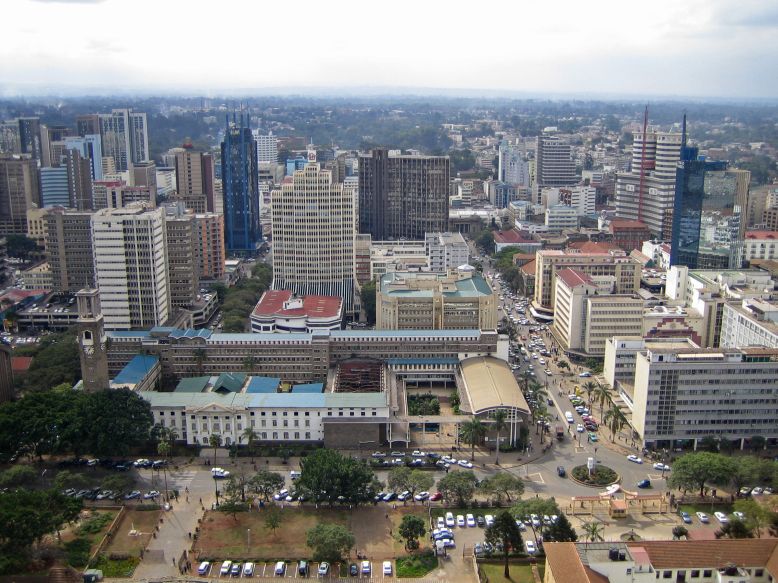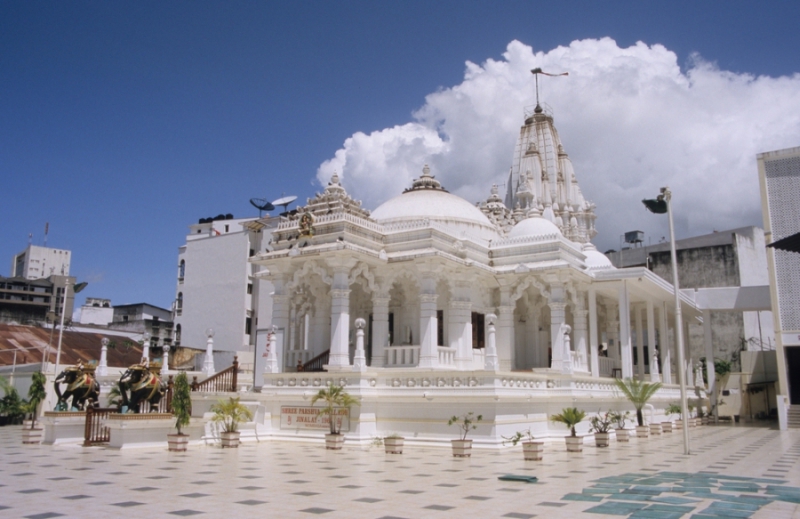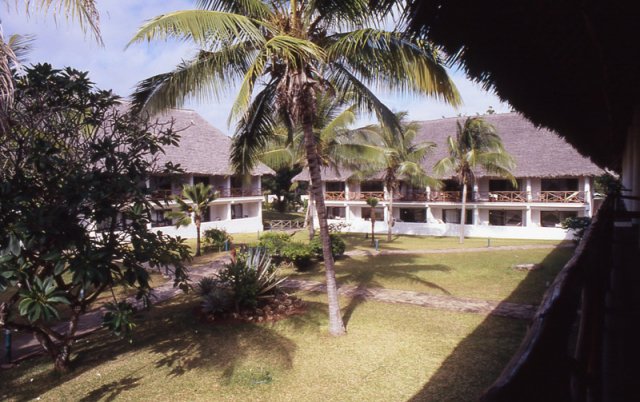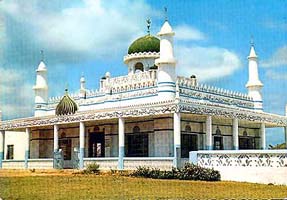

Area: 583 sq. km
Population: 30.8 million
Capital: Nairobi
Language: English, Swahili
Currency: Kenyan shilling
Average temperature: +14 +28 � C all year round
Kenya - Country in East Africa with an unusually beautiful and vibrant wildlife, ancient culture and history, picturesque and hospitable people. Kenya strikes by its geographic diversity - from snow-capped mountain peaks to extensive forests, deserts and wide plains. Main geographical attractions are located in the Great Rift Valley, with its extinct volcanoes, hot springs and geothermal areas, as well as on the coast of Kenya, with its coral reefs and gorgeous sandy beaches. The combination of a well-developed tourist infrastructure of hotels, resorts and lodges, and the rich flora and fauna, as well as a perfect warm climate, identifies Kenya as one of the most popular holiday destinations of thousands of tourists from around the world.
Climate in Kenya
In Kenya, the predominant
type of sub-equatorial climate. The hottest and driest place in Kenya -
the north-eastern plateau and vicinity of Lake Rudolf. In February and
March, daytime temperatures reach 36 here .. 38 degrees Celsius, and
night drop to 24 .. 26 degrees. In July and August, the day the air is
heated to +32 .. +34 degrees, and at night cooled to +22 .. +24 degrees.
In the Central Highlands temperature strongly depends on the altitude.
For example, in the capital, which is located at 1,800 meters above sea
level, in January, the day is celebrated around 25 degrees, and at night
- around 12 degrees in July - +21 and +11 degrees, respectively. At
higher altitudes at night frosts are frequent, and the highest point -
Mount Kenya - covered in snow all year round. On the coast, the climate
is mild. In January, the day the air is heated to +29 .. +31 degrees and
the night cooled down to 22 .. 24 degrees in July, daytime temperatures
reach 26 .. 28 degrees, and night - 21 .. 23 degrees.
During the year in Kenya celebrated two rainy seasons: pronounced - from
March to June - and less severe - from October to December. Most rain
falls on the southern coast of the Indian Ocean and to the west of the
country (on the eastern slopes of the Central Highlands). In these
regions have up to 1,500 mm of rain a year. In the far north-east of the
country has up to 500 mm of precipitation a year, while in the
north-western part of the country near Lake Rudolf - up to 200 mm of
rainfall per year.
Traditions of Kenya
Seven decades of British
colonial rule, which was preceded by a long period of slavery, has led
to the fact that many of the people of Kenya lost much of the cultural
heritage of the past. In the villages of Central Kenya now rare to hear
the sounds of tom-toms, see the dances at night campfire. "We are too
tired during the day in the fields of white, were too hungry in the
evening to dance the night" - spoken in uplands. Only in the northern
and southern parts of Kenya, to a lesser extent affected by the
influence of the colonizers, the best preserved cultural traditions and
everyday living in these areas Nilotic and Cushitic pastoral peoples.
In the process of historical development in Kenya has developed three
major historical and cultural regions corresponding resettlement major
ethno-linguistic groups of the country people: Bantu nilotov and
Cushites.
Bright and original Swahili culture that emerged in the coastal strip in
the area of the centuries-old contacts African, Arab and Indian
civilizations that went far beyond the ethnic groups, on the grounds
that it had been developed. White robe embroidered with silver and
GALABA hats men, blue-black coated with a la buibui women, large
rectangular house with windows in the countryside, rich cuisine, heavily
using seafood, Grand Bazaar, unknown in Central Kenya - all this gives
the coastal settlements bright color. Medieval appearance Swahili-sky
city retained, such as Lamu, due to its isolated geographical location
is almost completely avoided the destructive effects of the colonial
period. There is still work skilled craftsmen - jewelers, engravers on
copper, wood carvers and ivory. Alive the tradition of huge carved
doors, adorned with copper and chests inlaid with bronze. In communities
Pate, Vitu, Keepin, Mom-brui and other ruins of the majestic buildings
of the medieval heyday of Swahili civilization. Not far from Malindi
thickets rainforest hidden ghost town Gedi declared inviolable national
cultural monument.
Most people do not know the Kenyan wooden masks, widespread in West
Africa and the Congo Basin. When dancing or ritual ceremonies painted
directly face (Luo, Kikuyu, Kamba) or used woven grasses hoods with
slits for the eyes (luhya). Hence the difference between subjects Kenyan
carvers on subjects other masters of Africa: instead dominant throughout
the main story wooden masks Kenyan sculptors - figures of animals and
people. Art is a relatively new, it appeared mainly as commercial art,
designed for tourists. Per day up to a dozen carvers cut quite
skillfully made, but similar to each other like two drops of water, the
figures of elephants, rhinoceroses, or busts of soldiers. From the midst
of these artisans have identified a number of talented sculptors (Vanzhau
S., E. Nzhenga, D. Ki-Tusi).
Artistic traditions of the peoples of Kenya are embodied in many home
crafts and trades. Kikuyu, for example, reached a high skill in weaving
baskets and mats, and in recent years - and the furniture of the sisal
These products are decorated with bright geometric patterns. Kamba are
renowned as the best wood carvers. Richly ornamented their original
three-legged stool. Kisii in recent years have mastered the various
cutting and Di MSRP figures from soapstone.
The glory of the best dancers of Kenya won the long Kamba, dancing all
the growing pace and including dance acrobatics. No less masterly skill
measure and Embu - best tamtamistov Kenya. In military dances measure
and Embu men only, dressed in red and green robes, their heads high
crown caps, fur monkeys. Finally, giryamy known ceremonial dances
performed by the light of the fire.
The orchestra of folk instruments dominated string and wind. Kenyan
version of the violin - oluiko - is used on the coast, and the lira -
litunga - at luhya. Amadinda - a kind of xylophone - popular in Western
Kenya, and plucked marimba - among the Kamba. Huge, up to two meters in
length, is found in the horn of outpatient Luo.
Written literature was born in the Kenyan coastal city. Lamu and Pate
considered the main centers of the poetic school of Swahili coast. In
Pate gvorit classic literature Swahili Said Abdullah (1720 - 1820). in
Lamu Swahili poet Muyaka bin Haji Hassan al (1776 - 1840).
Written literature people inside Kenya arose only in the XX century. The
greatest modern writers and poets of the realist who dedicated their
works subject of the national liberation struggle, the decolonization of
African culture - Ngugi Wa Thiongo, M. Mwangi, G. Ogot, M. Gikaru, Okoth
d'Bitek, D. Kariuki.
In the past, a creative literary work was concentrated mainly around the
universities, literary works published on the pages of students of
university journals. Abroad (mainly in the UK) came out a limited number
of works of Kenyans. Currently, state publishing "East Africain
Publishing House" in Nairobi regularly publishes the best of Kenyan
writers, poets and writers.
Attractions in Kenya
Nairobi

Nairobi - one of the biggest cities in East Africa. English fort at the site of the city grew, was built at an altitude of almost two thousand meters to protect one of the first railways continent - Mombasa - Lake Victoria. The city a little more than 100 years, but during that time he was from a small village in the tiny oasis has become one of the most beautiful capitals of the African continent. The sights of Nairobi include Clock Tower in the city center, a modern business center, the Houses of Parliament to the mausoleum of the first president of Kenya, Jomo Kenyatta (1891 - 1978 gg.), The National Archives, the Indian quarter with dozens of magnificent Hindu temples, many mosques, Orthodox Coptic Church of St . Mark, Sikh temple, Railway Museum and the National Museum with a luxurious anthropology, "Snake Park", which serves national cuisine, as well as nearby Giraffe Centre Langat, Ngong hills and Nairobi National Park.
Mombasa

Mombasa - a former (until 1906), the capital of Kenya, one of the oldest cities in Africa and one of the richest ports Age of Discovery. Located on the island and connected to the mainland by a causeway, it still retained the appearance of a medieval city, which bizarrely united European, Arabic, Persian, and African traditions. There are interesting houses in the Arabic style, the Portuguese fortress Fort Jesus (XVI c.), The summer residence of the President of Kenya, as well as an oasis of Mzima Springs. Modern sea port in Mombasa - the second largest African port after Cape Town. But the main reason why tourists come to Mombasa - many kilometers of beaches to the north and south of town. Here, on the shores of the Indian Ocean, among shady palm groves, built a lot of first-class hotels and entertainment complexes.
Malindi

The ancient town of Malindi is much more interesting for tourists than the capital. Here you can find a cross set of Vasco da Gama (1498, the most ancient monument of the Portuguese on the coast), the first African church and tower of Vasco da Gama, and the whole neighborhood lined with luxury hotels. 16 km south of Malindi, lie the ruins of Gede (XIII c.) - One of the most intriguing cities in Africa. Excavations have revealed the city walls, gates and towers, homes, mosques and tombs, the great palace of the Sultan, as well as a developed system of wells and pools. It is still unknown what caused people to leave this once-wealthy city, so archaeologists are working on.
Cities in Kenya
Mambrui
 In Kenya the
borders of the main areas of settlement of the peoples of three major
language groups: Bantu nilotov and Cushites. About 65% of the African
population of Kenya speaks zykah Bantu. Representatives of the Bantu -
is by farmers Bantu central part (Kikuyu, Kamba), western Bantu (luhya,
Kisii), coastal Bantu (Taveta, Swahili). Nilotic people of Kenya -
Maasai, Samburu, Turkana - still live largely in isolation, preserving
ancient traditions ranchers and not mixing with the surrounding nations.
The peoples of Cushitic language group is 5% of the population and
inhabit the northern and north-eastern parts of the country.
In Kenya the
borders of the main areas of settlement of the peoples of three major
language groups: Bantu nilotov and Cushites. About 65% of the African
population of Kenya speaks zykah Bantu. Representatives of the Bantu -
is by farmers Bantu central part (Kikuyu, Kamba), western Bantu (luhya,
Kisii), coastal Bantu (Taveta, Swahili). Nilotic people of Kenya -
Maasai, Samburu, Turkana - still live largely in isolation, preserving
ancient traditions ranchers and not mixing with the surrounding nations.
The peoples of Cushitic language group is 5% of the population and
inhabit the northern and north-eastern parts of the country.
The extreme north-eastern regions populated nations Ethiopian race
(about 4% of the population). The small tribes of hunters who had found
a refuge in the mountain forests of central Kenya (eg ndorobo), perhaps
the descendants of the ancient inhabitants, representatives Khoisan
language group (Bushmen). There are also live Indians, Europeans (0.5%
of the population), Arabs (0.3% of the population).
Of non-African ethnic groups before the rest in Kenya settled Arabs.
Three quarters of the Arabs live in cities coast. The bulk of the
Indians came to Kenya in the period of British colonial rule in the late
XIX - nachaleXX century. These were contract workers employed in the
construction of the railway. Later, some of them are engaged in trade,
and educated have been taken in the colonial administration.